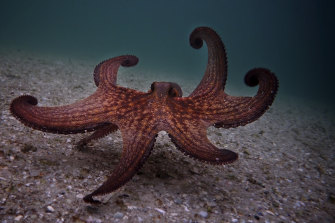
Though it is well-known for its many arms, the octopus does not seem to know where those eight appendages are most of the time.
“In the octopus, you have no bones and no joints, and every point in its arm can go to every direction that you can think about,” said Nir Nesher, a senior lecturer in marine sciences at the Ruppin Academic Centre in Israel. “So even one arm, it’s something like endless degrees of freedom.”

Scientists believe they have found a secret sense in octopus arms. Credit:My Octopus Teacher
So how does the octopus keep all those wiggly, sucker-covered limbs out of trouble? According to a study published this month in The Journal of Experimental Biology by Nesher and his colleagues, the octopus’ arms can sense and respond to light — even when the octopus cannot see it with the eyes on its head. This light-sensing ability may help the cephalopods keep their arms concealed from other animals that could mistake the tip of an arm for a marine worm or some other kind of meal.
Itamar Katz, one of the study’s authors, first noticed the light-detecting powers while studying a different phenomenon: how light causes the octopus’ skin to change colour. With Nesher and Tal Shomrat, another author, Katz saw that shining light on an arm caused the octopus to withdraw it, even when the creature was sleeping.









 Add Category
Add Category